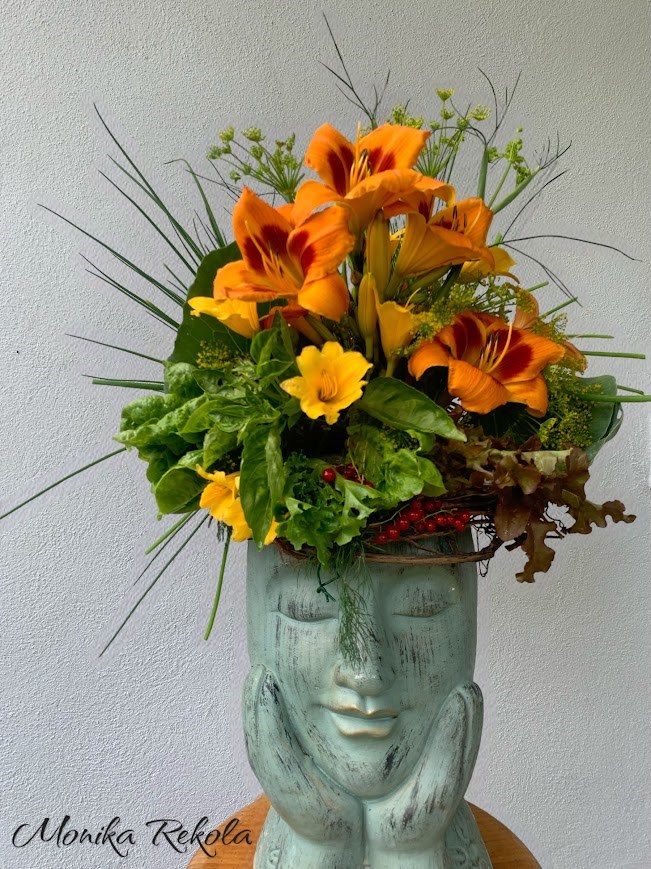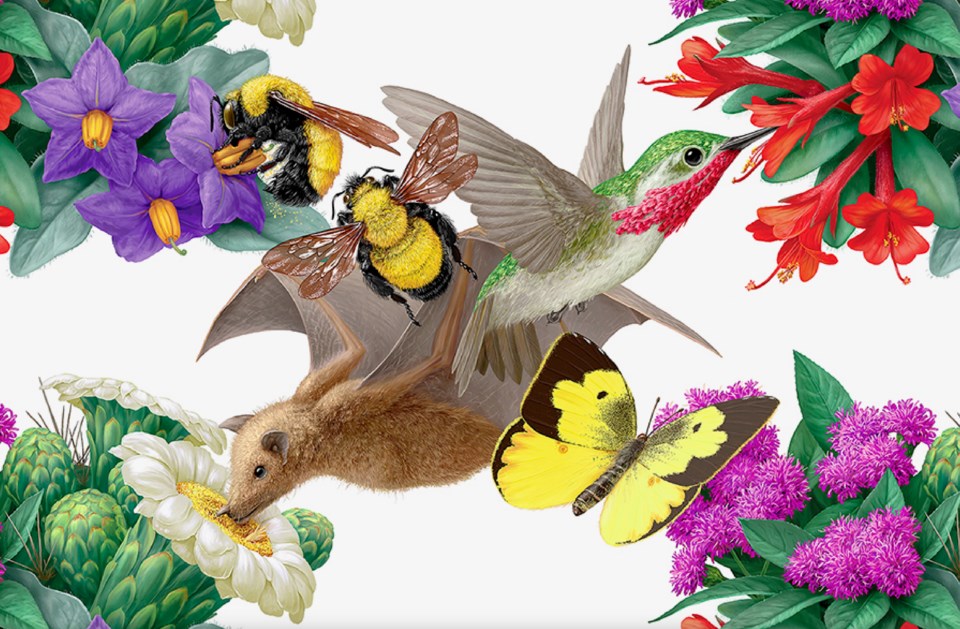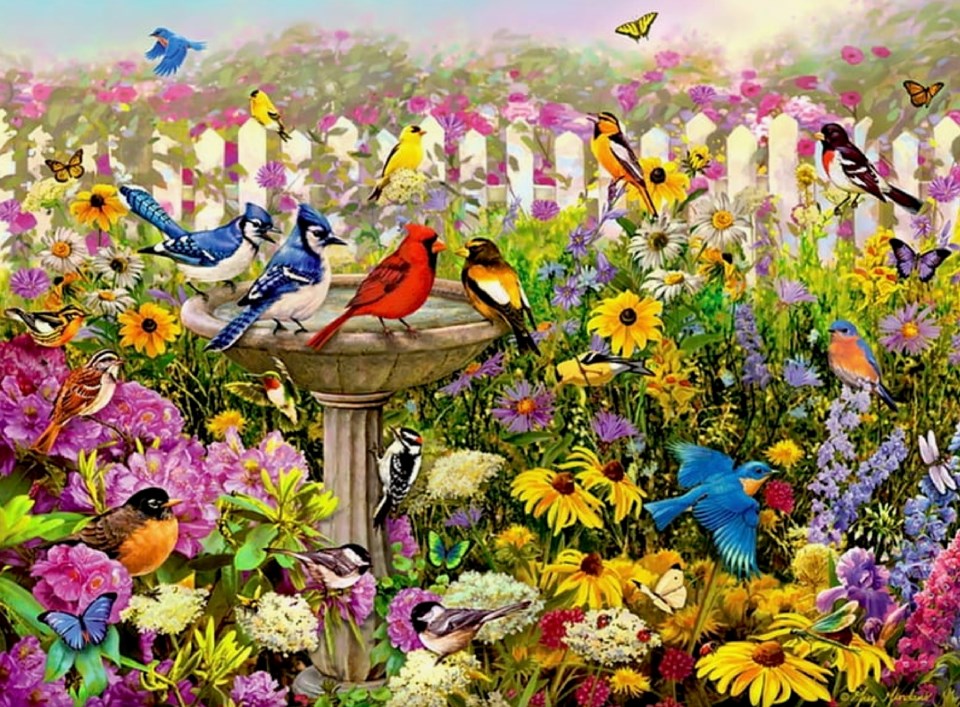Guess what, garden friends? This week’s Crown of Flowers isn’t just a feast for the eyes; it’s a delicious treat — an edible crown featuring red and green leaf lettuce, cabbage, basil, fennel, garlic chives, daylilies, and red currants.
This stunning display didn’t last long — it was quickly devoured as a delightful summertime salad.

Imagine for a moment you’re me: a monarch butterfly, embarking on a journey that spans thousands of miles. The world I see is not just a backdrop to my flight but a journey of survival, beauty, and change. My existence is intricately tied to the landscapes below, yet how I perceive these landscapes might differ drastically from how you, as a gardener or landowner, view them. I want to invite you to see through my eyes and understand the world from my perspective.
In traditional landscape design, we often envision beauty in terms of manicured lawns, neatly trimmed hedges, and vibrant flower beds arranged for human pleasure. But what if we adjusted our looking glass? What if we began to see our gardens and public spaces not only as esthetic statements but as critical habitats for creatures like me?
As a monarch, my survival hinges on specific plants and environments. Milkweed is not just a charming wildflower to me; it’s a vital nursery where my larvae thrive. Yet, the gardens I once roamed have changed. The lush meadows I remember from my earlier migrations are now fragments, replaced by expanses of non-native plants and monocultures.
This brings us to a concept known as shifting baseline syndrome. As generations pass, our expectations and perceptions of what constitutes a thriving landscape shift, often imperceptibly. For me, and many of my fellow pollinators, the decline in the richness of our habitats might seem gradual, but it is stark when compared to the vibrant landscapes that once existed.
I urge you to reconsider how you approach your green spaces. By shifting your perspective from traditional landscape design to a pollinator’s viewpoint, you can help reverse this syndrome. Imagine transforming your garden into a sanctuary where native plants flourish and where the air hums with the sounds of bees and butterflies.
Step 1: Plant native plants for native pollinators
Native plants are our lifeline. They are adapted to the local ecosystem and offer the specific nutrients and habitat we depend on. Without them, many of our food crops, like tomatoes, melons, and blueberries, would be left unpollinated. Please, before you spray any chemicals this summer, think of us. Bees, especially the native ones, are crucial for pollinating plants and ensuring the food system’s health.
Step 2: Create a pollinator buffet
Imagine a garden bursting with a variety of trees, shrubs, and flowers, each one offering a different flavour of nectar and pollen. This diversity helps us gather the energy we need to continue our vital work.
Consider planting native trees like the sugar maple, which offers early spring nectar and beautiful fall colours. The red maple is another favourite, with its early blooms and stunning red foliage. Fruit trees, such as apple, crab apple, cherry, pear, and plum, provide essential spring blossoms and delicious fruit.
Add shrubs like elderberry, serviceberry, or highbush blueberry to offer more flowers and berries. Perennials like wild bergamot, black-eyed Susan and Joe-Pye-weed.

Step 3: Plant host plants
Many of us, including monarchs, rely on specific plants to complete our life cycles. Swamp milkweed can brighten your garden while providing crucial resources. Butterfly weed, with its vibrant orange flowers, is a favourite of mine and my monarch kin. True to its name, it attracts legions of butterflies and serves as a crucial host plant for monarch and queen butterflies. Similarly, pussytoes and pearly everlasting are host species for painted lady butterflies, while the pawpaw is essential for the zebra swallowtail butterfly.
Lastly, the annuals inject long-lasting colour and nectar into the garden. Classic choices like cosmos, alyssums, impatiens and snapdragons are magnets for hummingbirds and bees.
Don’t forget that even vegetable gardens can be pollinator-friendly. Brassicas, a family of plants that includes vegetables like cabbage, kale, broccoli, and cauliflower, are often grown for their nutritious foliage. However, another bonus to us is to allow brassicas to flower, providing treats for pollinators. Herbs like fennel, rosemary, dill, and flowering tomatoes, peppers, and cucumbers provide a lively palette.
Replace traditional lawns with clover and wildflowers, creating areas that serve as both food sources and homes for us.
Rethink mosquito control
Be mindful of mosquito sprays. These chemicals are not just harmful to mosquitoes; they can be deadly to us.
Additionally, sprays can kill beneficial insects that naturally control mosquito populations, potentially leading to a resurgence of mosquitoes over time.
Could recent chemicals or pesticides be behind the death of 1.2 million bees at Mikkola Family Farm & Apiary in Lively, Ont.?
Have changes in local farming or chemical use affected bee health?
Are new chemicals or pollutants involved?
How do weather and environmental changes interact with chemical exposure?
Dawn Lalonde is raising funds to test dead bees, suspecting chemicals may signal a wider environmental issue.
Here are some eco-friendly mosquito control approaches:
- Regularly empty and clean containers that collect stagnant water.
- Use mosquito dunks to target larvae without harming beneficial insects.
- Encourage natural predators like dragonflies, frogs, bats, and birds.
- Plant mosquito-repelling plants such as citronella, lavender, marigolds, and catnip.
- Since mosquitoes are weak fliers, installing fans can also help keep them at bay.
Design tips for your pollinator garden:
- Group plants in clusters to make it easier for us to find our favourite flowers.
- Choose plants that bloom at different times to ensure a continuous supply of nectar.
- Provide water and shelter with a shallow dish in undisturbed areas in your garden.

As you create your garden paradise, remember to support local honey producers. These beekeepers provide safe habitats and care for bee populations, contributing to the health of pollinators and the sustainability of local agriculture. Though native bees and honeybees compete for food and habitat, we need both. Providing additional habitat for native bees helps balance this competition.
Great news from Little Lake Park: They’ve already rewilded a portion of the park and are now replacing their tiered ornamental gardens with pollinator-friendly plants. This is an awesome initiative and we hope they continue their ecological focus and expand these efforts.
I know the news can seem overwhelming — political turmoil, climate change, and the looming threat of ‘insectageddon’ make it feel like there’s little hope. But there’s a powerful action you can take. Native plants and animals are interconnected, and by planting native flowers and shrubs, you can help restore the habitats we’ve lost. The saying, “Plant it and they will come,” holds true for gardens like yours. By planning a welcoming space with native plants, you’ll be paving the way for us to thrive and make a meaningful impact.
With gratitude,
A monarch butterfly



